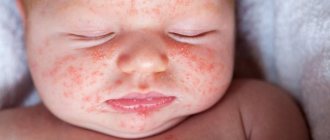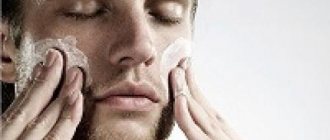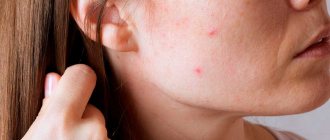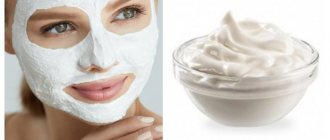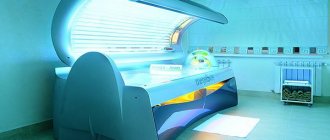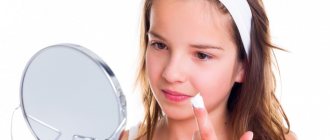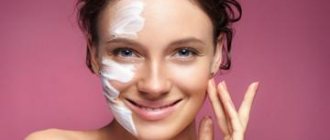Last update: 03/03/2021
Facial allergies often cause severe discomfort - not only physical, but also emotional. This is understandable, because the rash and redness in this area of the body is quite difficult to hide. In addition, dryness and flaking of the skin, burning and itching cause additional inconvenience.
On our website you will learn how to treat allergies on the face, and also find photos of types of allergies.
Facial allergies: causes
The mechanism of development of facial allergies is usually explained by abnormalities in the functioning of the immune system. Sensitization is a complex and highly individual phenomenon, so all people’s reactions to the same substance may be different.
One of the most common causes of facial allergies is heredity. Therefore, if one or both parents have an allergy, it is likely to be passed on to their child.
A tendency to face allergies can appear not only in infancy, but also throughout life. This likelihood occurs especially often after suffering from severe long-term illnesses that weaken the body. A long course of taking medications can also become a serious prerequisite for the appearance and development of allergic reactions on the face.
Recently, another factor has been identified that influences the occurrence of allergies. We are talking about a polluted environment. Also, the tendency to allergic reactions is influenced by chronic fatigue, constant stress, lack of sleep, unbalanced diet and other factors that undermine the body's defenses.
The following are the main causes of allergies on the skin of the face:
- Food allergies on the face are triggered by the consumption of certain foods. The most dangerous for allergy sufferers are nuts, berries, red fruits and vegetables, bee products, eggs, seafood, chocolate, citrus fruits, canned food, and chips.
- Physical contact with an allergen substance. The irritants are usually metal alloys, latex products, household chemicals, and so on. Allergies to cosmetics on the face are very common.
- Contact with animals. The protein produced by dogs, cats and other pets is often an irritant that can cause allergies in sensitive people in the form of rashes and spots on the face and eyes (eyelids).
- Sometimes allergies become the body's response to the use of medications or inhalation of certain substances (dust, pollen, chemical fumes).
- Insect bites. In some people, the bites of mosquitoes, horse flies, wasps and other insects become very swollen, swollen and red. Typically this reaction goes away within one to two days.
- Cold allergy on the face. It can manifest itself from a person being in a cold room or on the street, from wind, contact with cold water, and sometimes from drinking cold drinks and food.
- Allergy on the face to the sun (photodermatitis). It appears from exposure to direct sunlight.
Natural cosmetics = safe cosmetics?
Serum with a high content of vitamin C, tonic with essential oils and lemon, sea buckthorn cream. And no “chemistry”! Sounds tempting. True, this does not mean at all that an allergic reaction will not occur to these extremely “natural”, environmentally friendly products.
This may surprise you, but the most hypoallergenic products are synthetic, since they do not contain proteins that are primarily perceived by the immune system as foreign to the body and requiring immediate destruction. If you pay attention to children's cosmetics from serious large companies, the number one component there will be mineral oil. And not because “they want to destroy children” and “bathe them in oil,” but because this is the safest component that will not cause, for example, Quincke’s edema.
What does an allergy on the face look like: types
- Atopic dermatitis. This is one of the most common types of childhood allergies. It appears in the form of red spots, localized mainly on the cheeks and around the mouth. It is also possible for characteristic milky crusts to appear on the eyebrows. With such an allergy, the face itches and swells a little.
- Hives. The main symptom of this allergy is redness of the face, the appearance of rashes reminiscent of nettle burns. The rashes (blisters) rise slightly above the level of healthy skin and are very itchy and itchy.
- Contact dermatitis. Typically, for this type of allergy to occur, a long period of time must pass during which the person is in close contact with the irritant. The allergy manifests itself in the form of weeping erosions, in place of which dry scales then appear.
- Toxidermy. Allergens enter the body through inhalation of toxic substances, as well as through food. The allergy manifests itself in the appearance of macular or papular rashes on the face.
- Quincke's edema. If your face becomes swollen and swollen due to an allergy, it is quite possible that it is Quincke's edema. When it occurs, the features and shape of the face can change beyond recognition. The swelling is very dense, a person feels a strong tension of the skin, but pain rarely occurs. Most often, allergies affect the lips, eyelids and cheeks, causing breathing problems or difficulty.
- Eczema. It is characterized by the appearance of red allergic spots and small bubbles, inside of which there is a clear liquid. Over time, the bubbles burst, and in their place small, weeping wounds appear, which dry out and form scales.
Facial allergies: how to treat and how to diagnose?
Rashes on the face are not a reason to panic. In addition, additional stress can lead to an exacerbation of the disease. However, it is also impossible to let the development of an allergic reaction take its course, as this can lead to the development of serious complications. For example, if allergic weeping wounds get infected, purulent inflammation may appear.
It is not recommended to start treatment without consulting a doctor, as this can lead to serious consequences. Make an appointment with a doctor: treatment should be carried out under the supervision of experienced specialists - an immunologist, an allergist and a dermatologist, a therapist. To determine how to get rid of allergies on the face and what treatment to prescribe, the doctor will conduct a series of tests to determine the allergen. Usually, traditional prick tests are sufficient for this, but in some cases a venous blood test or provocative tests may be required.
If at the moment you cannot get to the hospital to consult with a specialist, do not worry. Follow these guidelines:
- Try to identify the allergen yourself. A rash on the face occurs due to poor-quality cosmetics, exposure to cold, wind, direct sunlight, eating certain foods, and long-term use of strong medications.
- Take an antihistamine. However, without consulting a doctor, it is better not to take medications that you have not tried before. Therefore, take only the medicine that has already been prescribed to you.
- Wash your face with La-Cri gel. This gentle product will gently remove impurities and moisturize the skin. In addition to its cleansing function, this product has anti-inflammatory, antimicrobial and healing effects, so it will be especially useful for allergies.
- Moisturize your skin with hypoallergenic La-Cri cream. This product does not contain fragrances, dyes or fragrances, so it is ideal for inflamed skin. It will relieve allergic itching, reduce peeling, heal small wounds and microcracks. Therapeutic cosmetics cover the skin with a protective layer without leaving an unpleasant sticky film: it can be used as a night cream or a base for cosmetics. “La-Cri” is a non-hormonal remedy, it is not addictive, which means it is suitable for long-term use for allergies.
- To mask redness and rashes from allergies on the face, use only proven products that do not contain aggressive ingredients, such as alcohol. Do not buy new cosmetic products - this may make the situation worse.
Severe allergies on the face: what to do and what products to use for treatment?
Facial allergy medications are divided into two categories – corticosteroid (hormonal) and non-hormonal. The drugs of the first group have a powerful effect, but their long-term use can be hazardous to health. Therefore, corticosteroid medications are usually resorted to in case of severe allergic reactions.
Non-hormonal medications for rashes and swelling on the face have a milder effect, so they are used for mild allergies. Also, non-hormonal drugs are most often prescribed to children or people with weakened bodies.
Allergy ointment for face
Ointments have a dense consistency. Due to their oily structure, they not only effectively cope with rashes, but also provide softening and nourishment to the skin.
- Elokom. Glucocorticosteroid ointment that has an antipruritic and antiallergic effect.
- Advantan. Provides fight against swelling, rashes, red spots on the face, and has an antipruritic effect.
- Lokoid. Corticosteroid ointment, the main active ingredient of which is hydrocortisone-17-buritate. Helps cope with itching and swelling of the face.
- Bepanten. A non-hormonal allergy remedy that provides a drying effect. Well suited for combating weeping erosion. The main active ingredient is dexpanthenol.
Allergy cream for face
Compared to allergy ointments, creams have a light and less dense structure. This ensures rapid absorption of the product.
- Dermovate. Glucocorticosteroid cream, the active component of which is clobetasol propionate. The use of the cream provides anti-allergenic and anti-inflammatory effects, relieves swelling, fights itching, burning and hyperemia. Well suited for cases where the face becomes swollen and itchy due to allergies.
- Elidel, Protopic is a non-hormonal anti-inflammatory drug.
- Skin Cap. The main active ingredient of this cream is zinc pyrithioneate. The cream effectively copes with allergic swelling and itching.
Preparations for internal use
In addition to local remedies, treatment of allergies should be accompanied by the use of antihistamines, as well as enterosorbents.
- Enterosgel. Enterosorbent, which ensures rapid removal from the body of toxic substances that cause allergies.
- Cetrin, zodak, zyrtec. The drug is available in the form of drops, syrup, tablets or solution. Has antipruritic and antiexudative effects. The first signs of the action of this medication are noticeable within an hour after administration.
- Telfast. A drug with pronounced antihistamine properties, manifested by blocking H1 receptors. There are side effects such as possible headache, insomnia, and tachycardia.
- Claritin. The active substance in these tablets and syrup is loratadine, which effectively relieves swelling and helps cope with severe swelling. Like many other drugs for internal use against allergies, it has a number of side effects: migraines, dizziness, nausea, rapid heartbeat.
Allergens in cosmetics according to European standards
In January 2007, the European Scientific Committee for Consumer Safety (SCCS) approved a special “List 26”. It included 26 substances that most often cause allergies in cosmetics, which, however, can be added to cosmetics, subject to mandatory inclusion on the label. Components from “List 26” are divided into two sections depending on the frequency of allergic reactions.
LIST A
“List A” includes components with a very high frequency of allergic reactions and with a large number of documented evidence.
- Amyl cinnamal is
a synthetic fragrance.
Amylcinnamyl alcohol
is a synthetic fragrance.
Benzyl alcohol
is a component of essential oils of jasmine, hyacinth, and ylang-ylang.
Benzyl salicylate
is a component of many essential oils.
Cinnamyl alcohol
is a component of cinnamon leaf essential oil, as well as Peruvian balsam and styrax.
Cinnamal
is a component of cinnamon bark essential oil.
Citral
is a component of many essential oils with a pronounced lemon sound (from lemon itself to verbena).
Coumarin
is a component of tonka bean essential oil.
Eugenol
is a component of essential oils of bay, cloves, cinnamon, basil, and nutmeg.
Geraniol
is a component of rose, palmarosa, and citronella essential oils.
Hydroxycitronellal
is a synthetic fragrance.
Hydroxymethylpentyl-cyclohexenecarboxaldehyde
is a synthetic fragrance.
Isoeugenol
is a component of ylang-ylang essential oil.
LIST B
“List B” includes components with lower frequency and less documented evidence.
- Anisyl alcohol
is a synthetic fragrance.
Benzyl benzoate is
a component of essential oils of tuberose, hyacinth, as well as Peruvian, Tolu and Copai balsams.
Benzyl cinnamate
is a component of Peruvian, Tolu and Copai balsams.
Citronellol is
a component of rose, geranium, and citronella essential oils.
Farnesol
is a component of many essential oils (from lemongrass to neroli).
Hexyl cinnamaldehyde
is a component of chamomile essential oil.
Lilial is
a synthetic fragrance.
d-Limonene is
one of the main components of citrus essential oils.
Linalool
is a component of many essential oils and is found in 200 types of plants from lavender to cinnamon.
Methyl heptine carbonate
is a synthetic fragrance.
Alpha-Isomethyl Ionone
is a synthetic fragrance.
Oak moss
- oak moss.
Tree moss
is the collective name for mosses.
La Cree products and their help in the fight against allergies
After the doctor tells you how to treat red spots and other manifestations of allergies on the face, you need to select products that will help restore the aesthetic appearance of the skin. La-Cri brand products, represented by creams, emulsions and gels, will help you with this. These products do not contain hormones, fragrances, harmful dyes, silicones and parabens. The use of La-Cri products is not addictive, so it can be used for a long time.
You can read about rashes on the stomach and ways to deal with them in the following sections.
Experts' opinion
The conducted clinical study proves the high efficiency, safety and tolerability of the product for daily skin care of children and adults with mild and moderate forms of atopic dermatitis and during remission, accompanied by a decrease in the quality of life of patients. As a result of therapy, a decrease in the activity of the inflammatory process, a decrease in dryness, itching and flaking was noted.
Based on the results of joint research, the following information is placed on product packaging: “Recommended by the St. Petersburg branch of the Union of Pediatricians of Russia.”
Sources:
- B.A. Shamov, I.G. Safiullina, A.B. Beshimova, T.B. Shamov, Differential diagnosis of atopic dermatitis, Journal of Practical Medicine, 2011
- Fokina R.A., Atopic dermatitis: stages of development of classification forms, Siberian Medical Journal, 2007
- A.N. Pampura, A.A. Chuslyaeva, Modern approaches to the treatment of atopic dermatitis in children
Photos of allergies in children
Photo album on the disease
How we take care of our clients
pays close attention to cosmetic ingredients. We use components from trusted laboratories that have the necessary safety and quality certificates. Before release, our products are tested in laboratories. For your convenience, we place detailed information about the composition and features of the use of our products on the packaging and in product cards in the official online store aravia.ru.
In case of an undesirable skin reaction to the product, we ask you to send us an email
- photos of skin reactions;
- photographs of the product so that the batch number is visible;
- a detailed story about exactly how you used the product;
- additional contacts for prompt communication.
We will then be able to help you and determine the possible cause of the reaction, and decide as quickly as possible how to proceed.

